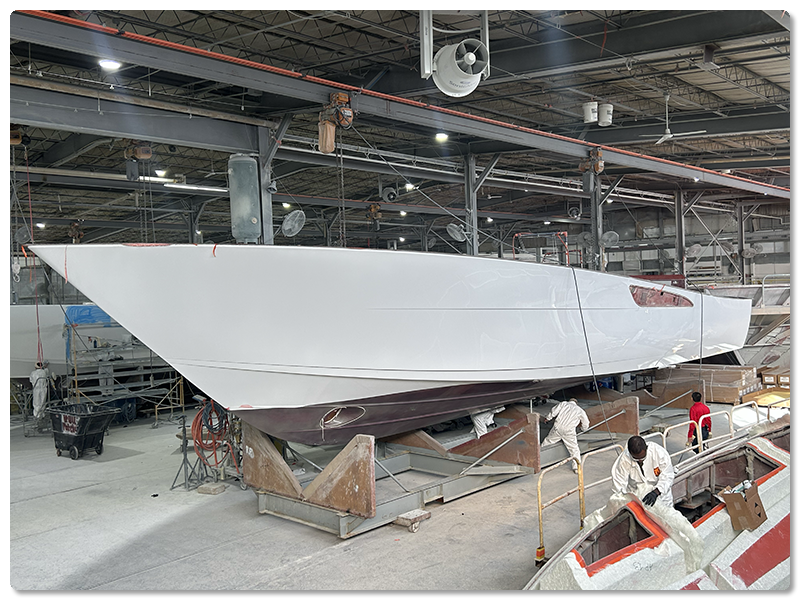
OVER 6 DECADES OF BUILDING A BETTER BOAT EVERY DAY
Founded by brothers Bill and Bob Healey on April 1, 1964, Viking climbed the marine industry mountain and has been at its peak for decades now, unwilling to relinquish the throne as the industry’s best boatbuilder.

2026 VIKING & VALHALLA VIP BOAT SHOW
Come see this stunning Viking 90 Sky Bridge at this one-of-a-kind event, Jan. 30-31, in Riviera Beach, Fla.

LATEST NEWS
The first Viking 64 Sport Coupe is moving steadily through its early build stages. Created for a longtime Jefferson Beach Yacht Sales owner, hull No. 1 is on track for completion in early June. The 64 SC uses the same hull as the 64 Convertible, while the mechanical and bulkhead arrangements differ to accommodate the coupe design.

HISTORY
Founded in 1964 by brothers Bill and Bob Healey, the Viking Yacht Company originated from their acquisition of Peterson-Viking Builders, a small, struggling manufacturer in New Jersey that specialized in 37-foot wooden sportfishing boats. Following Bill's mantra of building a better boat every day, the company has evolved into a global leader in semi-custom fiberglass yacht production, delivering more than 5,500 boats.

VIKING MARINE GROUP
Never resting on our laurels, Viking is in a constant state of growth. The Viking Marine Group is a result of that evolution, consisting of seven businesses under one family-owned vertically integrated company. We deliver the industry’s best turnkey-ready boats, supported by world-class service for the ultimate ownership experience.

SERVICE
When you head to sea, you are not alone! The Viking Marine Group operates two service yards in Florida and one in New Jersey, supporting our three brands of Viking Yachts, Valhalla Boatworks and Princess Yachts. The Riviera Beach, Florida, location has expanded to include the Valhalla Yacht Sales Showroom and Service Center, specializing in outboard boat sales and service.
Copyright 2025 Viking Yacht Company All Rights Reserved.
2026 VIKING & VALHALLA VIP BOAT SHOW
Come see this stunning Viking 90 Sky Bridge at this one-of-a-kind event, Jan. 30-31, in Riviera Beach, Fla.

Latest News
As Viking's only e-newsletter, the Viking View delivers in-depth stories from the factory floor, previews of upcoming models, tournament news and behind-the-scenes looks at the people building a better boat every day.
VIEW MORE

HISTORY
Founded in 1964 by brothers Bill and Bob Healey, the Viking Yacht Company originated from their acquisition of Peterson-Viking Builders, a small, struggling manufacturer in New Jersey that specialized in 37-foot wooden sportfishing boats. Following Bill's mantra of building a better boat every day, the company has evolved into a global leader in semi-custom fiberglass yacht production, delivering more than 5,500 boats.
VIEW MORE

VIKING MARINE GROUP
Never resting on our laurels, Viking is in a constant state of growth. The Viking Marine Group is a result of that evolution, consisting of seven businesses under one family-owned vertically integrated company. We deliver the industry’s best turnkey-ready boats, supported by world-class service for the ultimate ownership experience.
VIEW MORE

SERVICE
When you head to sea, you are not alone! The Viking Marine Group operates two service yards in Florida and one in New Jersey, supporting our three brands of Viking Yachts, Valhalla Boatworks and Princess Yachts. The Riviera Beach, Florida, location has expanded to include the Valhalla Yacht Sales Showroom and Service Center, specializing in outboard boat sales and service.
VIEW MORE
Stay in Touch
Please enter your email address to receive the latest information from Viking Yachts.
Copyright 2025 Viking Yacht Company All Rights Reserved.












